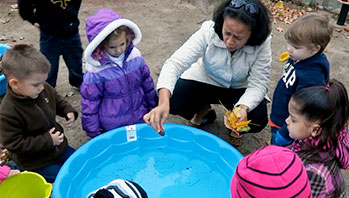- camera or cell phone with camera
- crayons or markers (one for each child)
- paper
- paper sack or plastic baggies (for collecting)
- small spiral-bound notebooks (one for each child with child’s name on front) or make simple notebooks out of paper and staples
- string
- environment
- ground
- flower
- plant
- tree
MA Standards
Language/L.PK.MA.6: Use words and phrases acquired through conversations, listening to books read aloud, activities, and play.
MA Draft Standards
Life Sciences/From Molecules to Organisms: Inheritance and Variation of Traits/LS1/3.C: Use their sense in their exploration and play to gather information. [Structure and Function]
Life Sciences/Ecosystems; Biological Evolution/LS2/4.D: Determine the variety of living things in a local area and characteristics of the places where they were found.
Head Start Outcomes
Logic and Reasoning/Reasoning and Problem Solving: Classifies, compares, and contrasts objects, events, and experiences.
Science Knowledge/Scientific Skills and Method: Uses senses and tools, including technology, to gather information, investigate materials, and observe processes and relationships.
Science Knowledge/Scientific Skills and Method: Observes and discusses common properties, differences, and comparisons among objects.
Science Knowledge/Scientific Skills and Method: Collects, describes, and records information through discussions, drawings, maps, and charts.
PreK Learning Guidelines:
English Language Arts/Language 2: Participate actively in discussions, listen to the ideas of others, and ask and answer relevant questions.
Science and Technology/Inquiry Skills 4: Record observations and share ideas through simple forms of representation such as drawings.
Science and Technology/Living Things and Their Environment 15: Use their senses of sight, hearing, touch, smell, and taste to explore their environment using sensory vocabulary.
Explore Together (outdoors): Outdoor Plant Walk

© Commonwealth of Massachusetts, Department of Early Education and Care. All rights reserved.
STEM Key Concepts: There are many different types of plants and seeds; Plants have different parts: roots, stems, leaves, and fruit; Plants grow in many places; Plants often grow in some type of dirt
ELA Focus Skills: Follow Directions, Speaking and Listening, Vocabulary
Educator Prep: If you are making notebooks for children, fold several sheets of white paper in half and staple them inside a construction paper cover. While outside, gather a small twig for each child to distribute as children leave for the day.
Safety Tips:
- Be aware of and check areas for poison ivy, poison sumac, nettles and bushes with thorns before taking children outside.
- Remind children to wash their hands before and after the activity.
- Remind children not to eat any plants or touch any plants without asking an adult.
- Children’s allergies need to be taken into account before going outside.
Tell children you are going to take them outside to explore plants in their environment. Review some important rules about exploring outdoors. Discuss how to be safe outdoors and how to treat outdoor plants with care. Record basic rules on a chart, for example,
Things that are okay to do while exploring outdoors:
- Collect parts of plants that have fallen on the ground (twigs, leaves, nuts)
- Observe plants with our eyes and magnifying lenses
- Touch and sniff growing plants only after an adult says it is okay
Things that are not okay to do while exploring outdoors:
- Break off bark, twigs, leaves, or flowers (that can hurt or kill a plant)
- Put berries, leaves, twigs, or ANYTHING in our mouths
Have children think about, talk about, and get excited about plants by asking questions such as,
- What kinds of plants have you noticed outside around the school? Big ones? Little ones?
- Can you describe one plant you have noticed in the outside school environment?
Then introduce the science notebook and explain to children that they will be drawing and writing to record their observations as they explore plants.
Hold up a notebook and tell children that each of them will have their own science notebook. Distribute the notebooks and lead children outdoors. Bring colored pencils in the colors of different plants.
Once outside, allow plenty of time for children to explore plants freely. Take photos of children's explorations and encourage children to draw the plants they observe and record their findings in their notebooks. As children explore, watch and listen for opportunities to support their inquiry into plants. Ask questions such as,
- What do you notice about how that plant looks, feels, smells?
- What do you notice about the area around the plant (its environment)?
- What do you notice about how these plants are the same/different?
Before leading children inside, ask them each to look on the ground around trees and other plants for plant parts on the ground, like leaves, seeds, twigs, needles, nuts, etc. Have each child bring in two samples and place them at the Science Table for further exploration during the week. (Make sure there are a few seeds in the collection for later discussions.)
Reflect and Share
Have children share their notebooks and describe something they observed about plants. Discuss some of the plant materials children collected by asking questions like: Examples include,
- What did you notice that was different about the grass clippings in the playground that had just been mowed and the ones that were in the field and mowed a few days ago?
- What did you notice about the bark at the spot where the branch came out of the tree that was different from the rest of the bark? (color, texture, etc.)
- What did you notice about the location that had the most plants growing in it?
- How were plants growing in different locations (environments) the same/different?
Educator Tip: In coming weeks, some of the trees might go through changes. For example, there may be new leaves, flowers, or cones, or the leaves may change color or fall off. If so, have children observe the changes. Take photos so you have a record of the differences.
